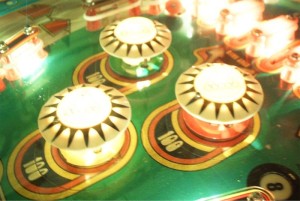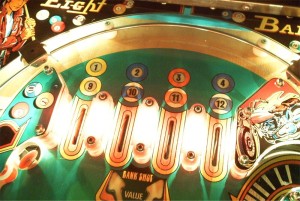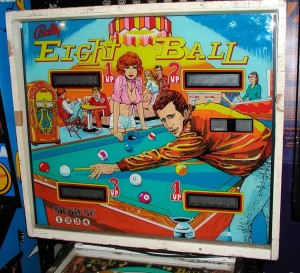I should really buy a flash.
I decided to set up the Nikon and take some marginally better photos of the Eight Ball machine.
Please enjoy.
Enchantments and Curiosities

I decided to set up the Nikon and take some marginally better photos of the Eight Ball machine.
Please enjoy.

So today, I had some time to do repairs so I heated up the soldering iron and jumped in.
The dead flipper was my first task.

The underside of the flipper assembly. I thought for sure this solenoid was dead, as it looked burnt.
I went thru pulling it off the play field and noticed that the ground wire had snapped off at some point. I cleared some insulation from the wire and connected it again, flipper moved. So I soldered it and now I have an extra flipper solenoid for the future. Also, the new flipper is slightly thinner in design…

I ordered new rubber pieces for the whole game as they were very dried and rotten.

Here is a kicker switch with the cover removed. I had to adjust the bump switches on either side of the kicker leg. Notice the rectangle piece of metal that is outside of the rubber ring? That had to move to the inside of the kicker assembly. Now when a ball hits any piece of that leading rubber edge, the ball gets launched away by the kicker.
Here’s the play field with new rubber.

The machine’s sounds are produced by an electro-mechanical chime box.
I noticed that there were 4 chimes that play “call to the post” when you hit the start button. The lowest key never plays.
This solenoid controls the lowest note on the chime box. It was so fried that the inside of the shaft expanded and caused the plunger to bind. I’ll need to order one of these.
The backbox was where I found the first fried circuits. Its basically the brain of the machine.

These boards control Lighting, Processing and Memory, Electrical Routing, and Switch/Solenoid operation. This is what’s behind the scoreboard.
After I did this maintenance, The game was repaired enough to play it. I had to adjust a few switches and things to work out the kinks, but now it basically works.
I have a few more issues to deal with that I’m going to have to wait to get to:
The “Ball Display” needs cleaned inside the lenses. There is dirt and soot under these lenses from the lights burning. It should clean up with some alcohol.

There’s a weak capacitor somewhere, as when the bumpers are hit the lights on the game dim. It could also be fixed by replacing the #45 lights with #47 as they are far more efficient.
The plasma in the scoreboard flickers.

Also, if you put 1 quarter in, you’re supposed to get 1 credit. Right now it gives you 20. When I was a kid at the arcade, I would have killed for that ability.

Here, I took some detail photos to show off some of the design elements of the game. Sometime soon I’ll have a proper shoot with a better camera. I promise.
You should be able to click on any image, or just page thru the gallery in the light box.


Manufacturer: Bally Manufacturing Corporation (1931-1983)
Project Date: January 17, 1977
Date Of Manufacture: February 21, 1977
Model Number: 1118-E
Production: 20,230 units (confirmed)
Notable Features: Flippers (2), Pop Bumpers (3), Slingshots (2), Stand up targets (4), Roll under spinner (1), Left out lane kickback.


Maximum displayed point score is 999,990 points per player.

Design by: George Christian
Art by: Paul Faris
Although Eight Ball is a solid state machine, sound is not generated by a sound board. Instead, a 4-note MPU controlled chime box produces the sound for this game.

This provides the experience of solid state scoring and response, with the added nostalgia of Electro-mechanical chimes.
The BONUS BALLS in the center of the lower play field are designated balls 1-7 for Players 1 & 3, balls 9-15 for Players 2 & 4.
Artist Margaret Hudson, who assisted Paul Faris on this game as a learning experience, says those are her initials on the bracelet of the girl in the back glass.

Two of the light shields are unusual as they have a second screening of red on top of the normal screening. This causes an effect similar used on the “Phantom of the Opera” glass, though no one probably would ever normally notice. For instance, “Pinky Tuscadero’s” shirt on the slingshot plastic appears red when the game is on, and tan when it’s off.
The representation of Henry Winkler’s Fonzie character from the TV show Happy Days in the artwork was not licensed and caused a problem after it was released.

Just picked up the 1977 Bally Eight Ball machine yesterday February 21st 2009.
Here are the initial observations. This is a compilation of several build log entries from before this site was online.
Here are the original sales brochures: for the machine
And here are some schematics:
Funny, the serial number says that it was built on February 21st 1977, its the machine’s birthday!
The Eight Ball machine was found in a basement, left dusty and alone in a corner for years. The owner said he’s not had it running since the late 1980s.
But, it still lights up.
He said I could have it, but I paid him a bit for his troubles and for good karma.
Wow was this thing hard to move. The backbox does not fold down so it makes it very hard to move. Perhaps next time I’ll try to unbolt/unwire it.

When Eight Ball is plugged in, most of the lights light up but the machine never fully boots.
Here’s a list of things I notice to be damaged or worn out.
I found a way to run a test of the Machine Systems using a red button inside the coin acceptor. Using this I found why it won’t turn on.
The test fails when it tests memory module U8. The CMOS and NRAM.
I removed and reset the PROM on the chip and reinserted.
I can get the machine to activate it’s self test and fully boot to ready status now.
I found that some of the lights that weren’t working are burnt, and some are just loose, so I fixed the ones I could, I’ve ordered #47 lights to fix the others.
The left flipper is totally fried, it doesn’t move. I’ll have to order a new solenoid.
The outhole kickback doesn’t detect the ball, I bent the contact up a bit on the switch and now it works.
All of the rubber on the playfield is very dry and crumbly, I’ll have to order a set.
The playfield needs waxed and cleaned, it seems to have needed this love for many years.
All switches now seem to function.
One of the chimes (the lowest pitch) doesn’t ever activate. I am unsure at this point if it is a solenoid or a wiring problem.
I took the backglass and hid it so it can’t be scratched, as its an original hand painted, and has the artist’s signature on the back, bonus!
I’ll try to get some more pictures in later posts, as its not very photogenic in this stage.